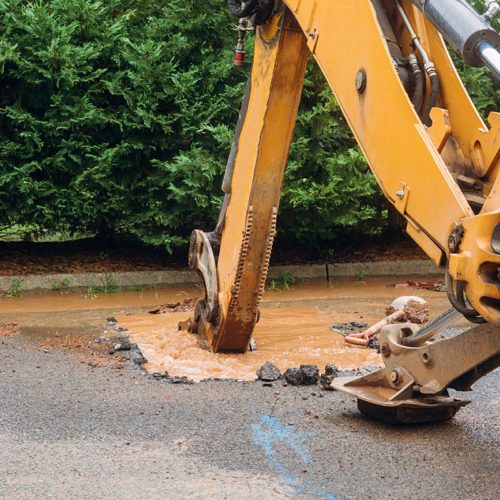Anyone digging must contact OKIE811 to have facility operators locate and mark their underground lines.
Education
Raising public awareness and educating people about the best practices for preventing damage is a crucial aspect of the OKIE811 Damage Prevention program. The OKIE811 provides access to educational videos, events and programs to help you stay educated on safe digging.

Professional Excavators and Contractors
Excavator Education Program
This 811 Certification is a 1½-hour online program designed for professional excavators. This program provides comprehensive training on damage prevention to prevent accidental damage to underground facilities during excavation.
Course content is specific to Oklahoma and the Underground Facilities Damage Prevention Act, as well as Contact Center procedures and Best Practices. To receive their certification, the student must pass a 25-question test at the end with 80% or better.
The chapters in this program cover:
- Planning and Administration of Excavation Projects
- Site Preparation and Actions for Safe Excavation
- Trenching Dangers, Damages and Consequences


Underground Facility Operators
Facility Operators Portal Help
The OKIE811 Portal is a great resource for Facility Operators to respond to locate requests, pull real-time reports, monitor ticket transmissions and much more. Here you can find helpful information on each feature of the portal.
Facility Operators Portal Tutorials
Below you will find tutorials that will guide you through the member portal:
Request Safety Information
OKIE811 provides Underground Facility Safety Education online and on-site. You may request training at our corporate conference room, dedicated webinar or on-site training at your location. We will provide OKIE811 promotional items and resources for those who attend. For webinars, we will mail items and resources to you before the webinar.
Safety Video Library
Excavator Responsibilities Mandarin Traditional Chinese
Podcast | Special Podcast with OGA: Susan Bohl on New Law Changes
Excavator Testimonial Video
OKIE811 Presents: “4 Steps for a Safer Excavation”
Okie811 MLS v5
OKIE811 Presents: “Why You Should Contact 811”
Free Education Offerings
Webinars
- Scheduled – Register to attend.
- Dedicated – Contact us to request a topic and schedule a date/time for your organization.
- Watch recorded webinars
Educational Workshop
- OKIE811 Conference Room
- *On-site at your designated location
811 Certification
- Individual Online Certification – New Updated Course Coming Soon
- At your pace learning.
Premium Education Offerings
OKIE811 Facilitated Group 811 Certification
- OKIE811 Conference Room
- *On-site at your designated location
- Workshop without a meal – $10 a person
- Workshop with a meal – $25 a person.
*Attendance Requirements for On-site Workshop or Facilitated 811 Certification
Types of Locate Requests
Normal Locate Request
A normal locate request is a non-emergency request where the excavator contacts OKIE811 48 hours (excluding Saturdays, Sundays, legal holidays and the date of notification) before excavation and not more than ten days before excavation.
Emergency Locate Requests
The law only provides an exception to the 48-hour notice (excluding Saturdays, Sundays, legal holidays and the date of notification) in emergencies. An emergency is an unavoidable situation that endangers life, health or property. In an emergency, excavation may begin immediately. Excavators must use extra care and precaution to protect underground facilities. Excavators should try to call before digging, but if they are unable, they should contact OKIE811 as soon as possible.
Demolition Request
By Oklahoma law, before demolition of a structure begins, operators of the underground facilities in the geographic area shall be given at least seven business days’ notice; this excludes Saturdays, Sundays, legal holidays and the date of notification. This notice shall be given to the notification (One-Call) center after the excavator has met local code requirements for a demolition permit.
Important
This notice does not replace the excavator’s responsibility to directly notify the operators of the underground facilities to disconnect the lines. This seven-business days notice is only for the intent of demolition, and the excavator shall notify the one-call center once again no less than 48 business hours before the demolition work begins.
Design Work - List of Companies Only
No marking of facilities will take place. OKIE811 will provide a list of registered members located within certain legal descriptions. It is then the requestor’s responsibility to contact those member companies to discuss their project.


